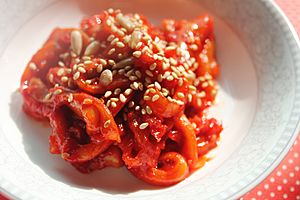Ojingeo-jeot facts for kids

|
|
| Alternative names | Salted squid |
|---|---|
| Type | Jeotgal |
| Place of origin | Korea |
| Associated national cuisine | Korean cuisine |
| Serving temperature | 4–10 °C (39–50 °F) |
| 20 kcal (84 kJ) | |
| Korean name | |
| Hangul |
오징어젓
|
|---|---|
| Revised Romanization | ojingeo-jeot |
| McCune–Reischauer | ojing'ŏ-chŏt |
| IPA | [o.dʑiŋ.ʌ.dʑʌt̚] |
Ojingeo-jeot (오징어젓), also known as salted squid, is a yummy Korean side dish. It's a type of jeotgal, which means it's made from salted seafood. This special dish is created by taking thin slices of squid and letting them ferment. Fermentation is a process where good bacteria help to preserve food and give it a unique flavor.
Ojingeo-jeot is a very popular banchan (side dish) in Korean cuisine. It's not just tasty; it's also packed with good stuff like protein, vitamins, and minerals, making it a healthy addition to any meal.
Contents
How is Ojingeo-jeot Made?
Making Ojingeo-jeot takes a few steps, but it's how the squid gets its special flavor and texture.
Preparing the Squid
First, the squid is cleaned carefully. This means its skin is removed, and it's gutted (cleaned inside). Then, it's washed very well. After cleaning, the squid is salted with coarse salt. It then sits and ferments for about three to four days. This first fermentation step helps to start the preservation process.
Aging and Seasoning
After the first fermentation, the squid is drained to remove extra liquid. It's then salted again and left to age for a longer time. This aging can last from three days up to a whole month! This step is important for developing the deep flavors.
Once the squid is perfectly aged, it's washed again. Then, it's cut into thin strips, which is sometimes called "julienned." Finally, these squid strips are mixed with a delicious seasoning paste. This paste usually includes:
- Gochutgaru (chili powder) for a bit of spice
- Mullyeot (rice syrup) for sweetness
- Aekjeot (fish sauce) for a savory taste
- Freshly chopped scallions
- Minced garlic
- Ground ginger
- Sliced chili peppers
- Toasted sesame seeds
- A drizzle of sesame oil
All these ingredients come together to create the unique and delicious taste of Ojingeo-jeot.
Different Kinds of Ojingeo-jeot
While Ojingeo-jeot usually uses common squid, there are some interesting variations.
Jeju Island's Hanchi-jeot
On Jeju Island in Korea, a different type of squid is sometimes used. This squid is called mitre squid, or hanchi (한치) in Korean. Because of this, the jeotgal made from mitre squid can be called hanchi-jeot (한치젓) or hanchi-ojingeo-jeot (한치오징어젓). It's a special local version!
Similar Dishes in Japan
If you travel to Japan, you might find a similar type of salted seafood. In Japan, this category of dishes is called shiokara. A dish that's very much like Ojingeo-jeot is known as ika-no-shiokara (イカの塩辛) in Japanese. It also features salted and fermented squid, showing how different cultures can have similar food traditions.

